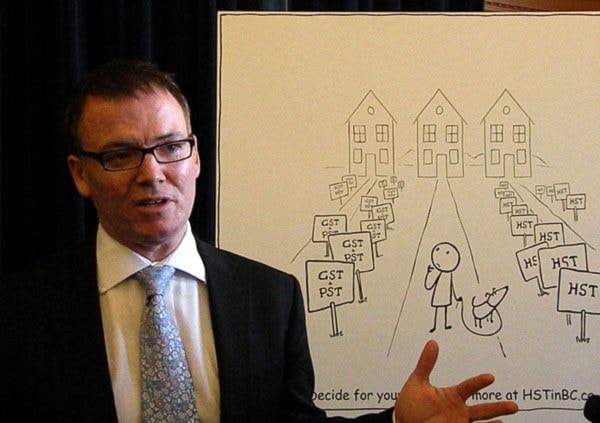VICTORIA – By now you’ve probably seen part of the B.C. government’s “stick man” ad campaign to raise awareness of the harmonized sales tax.
Stick men, or rather stick persons, sort out conflicting claims about the tax by going to the B.C. government’s website to get an accurate summary of what is and isn’t costing them more.
Later versions will no doubt feature stick persons checking their mail for brochures offering arguments for and against the HST, and of course, those all-important mail-in ballots that will arrive in June.
This is an urgent pre-requisite to an informed vote. Anyone who listens in to a telephone town hall or phone-in show, or gets reader feedback such as I receive, knows that the basic facts are still widely misunderstood.
So what does the NDP opposition focus on? The ads cost $5 million, grumbles NDP finance critic Bruce Ralston. Add that to town halls and mailers and the referendum funding boils down to $7 million for pro-HST and a mere $250,000 for the FightHST effort.
This is a classic “straw man” argument, where one sets up a false premise and then knocks it down. The ads do not advocate, they merely inform.
Stikine MLA Doug Donaldson propped up the NDP’s oldest scarecrow, that big “Liberal donor corporations” are the main beneficiaries of the HST. This is a vital point for rural B.C., which depends on resource industries with huge machinery investments, and he has it exactly wrong.
In fact the entire ‘big business benefits most from HST’ narrative is false.
Vancouver tax lawyer David Robertson points out that this is one of the “myths and misrepresentations” propagated by Bill Vander Zalm, who has effectively set NDP tax policy since their limping retreat on the carbon tax.
In 24 pages, Robertson has written the clearest analysis I’ve seen so far, including a thorough demolition of Vander Zalm's crude scare campaign known as FightHST, which has singled out banks and large resource companies.
Robertson notes that banks are actually worse off.
“…unlike most businesses, banks, financial institutions and insurance companies cannot recover GST/HST they pay on expenses,” he writes. They actually pay more under HST than they did under the old provincial sales tax (PST).
As for FightHST’s other specified villains, “large corporations” and “large resource companies,” their machinery and production equipment were long ago exempted from sales tax. No change there.
“What the PST legislation did not contain were PST exemptions aimed specifically at small, independent businesses,” Robertson writes.
“So construction workers like welders, plumbers, electricians and other tradespersons had to pay an additional seven per cent PST on their work trucks, tools and equipment that they used to earn a living; retailers and corner store operators had to pay an additional seven per cent on their shelving, refrigerators and cash registers; accountants and other professionals had to pay PST on their office furniture, computers and software; truckers had to pay an additional seven per cent PST on their truck tractors and trailers …” and so forth.
This is what the HST fixes.
Obviously, Big Labour doesn’t like all these independent contractors. Therefore the NDP must also “fight” HST.
I’ve mentioned before that the NDP-Vander Zalm axis of nonsense wants to deprive the poor of a modest tax shift in their favour, paid for by voluntary purchases of more affluent consumers.
I’ve talked about the trend towards self-employment and small business as the Canadian economy adapts in a fast-changing world. You may not like that trend, and you may wish that everyone could have a union job with an employer-subsidized pension.
That’s not what is happening today.
Tom Fletcher is legislative reporter and columnist for Black Press and BCLocalnews.com
tfletcher@blackpress.ca
twitter.com/tomfletcherbc
